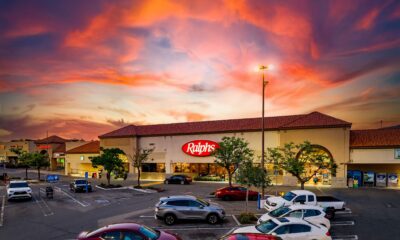Career & Workplace
The Workforce of the Future: Navigating Industry 4.0

The Workforce of the Future: Navigating Industry 4.0
By Bansree Parikh, Business Banking Market Executive for Bank of America in the Inland Empire
Tech innovation is prompting transformation so significant it’s often referred to as a fourth industrial revolution, or Industry 4.0. Industry 4.0 technologies range from facial recognition software to voice-activated virtual assistants and self-driving delivery trucks, to name a few. According to a study from the UC Riverside School of Business Center for Economic Forecasting and Development, the Inland Empire can be successful in growing its tech workforce by linking to its anchor industries, such as logistics, agriculture and green tech. Cities like San Diego and Austin have succeeded by focusing efforts on one or two key industries that already play a significant role in their respective economies. There is clear opportunity for growth in this sector, and businesses that embrace these technological advances will reap the rewards of increased efficiency and, ultimately, boost their bottom lines.
Here are a few insights into how businesses and employees can capitalize on the future of work:
Who will do the work?
With the rise of automation technologies like self-service ordering kiosks in restaurants, cashier-less convenience stores and driverless vehicles, they are even taking the place of some customer-facing positions. Yet, tech innovations are also creating new jobs and opportunities for employees. Employers should start thinking about preparing for roles that offer higher value work and require greater skill – such as those positions that will be needed to service new technologies. As automation becomes more prevalent, businesses shouldn’t lose sight of the human qualities that have enabled them to succeed.
How will work get done?
While some jobs will become fully automated, other positions will require a unique blend of technology and human touch. Workers will need to up-level their talents to qualify for higher-skilled positions. According to the World Economic Forum’s 2018 Future of Jobs report, no less than half of all workers are expected to require significant reskilling or upskilling over the next three years. Businesses should consider offering employees the resources and training support they’ll need.
When will we do our work?
For many, the meaning of work-life balance has changed to be less about a distinct separation between work and personal life and more about being able to easily pivot between the two, no matter whether in the office or on the go. The workforce of the future will demand speed, convenience and ease of use from the technology they use to do their jobs, the same as they expect from the products they use in their personal lives.
The workforce of the future
Digital transformation is inevitable. While the many changes may seem daunting, automation was created to enhance our lives, and this will be as true in the workplace as in our personal lives.
Bansree Parikh is a Business Banking Market Executive for Bank of America.
Career & Workplace
Inland Empire Unemployment Ticks Up to 5.1% in July

Job Market Dynamics Shift as Healthcare, Construction, and Business Services See Growth While Manufacturing Jobs Decline
- Data shows more people are entering the job market in Riverside and San Bernardino counties
- Private employers added a total of 5,400 jobs in July led by Healthcare and Social Assistance, Professional and Business Services, and Construction
- Manufacturing lost another 300 jobs in July, down a total of 2,700 (2.7%) from a year ago
According to the Inland Empire / Desert Region Center of Excellence for Labor Market Information, Inland Economic Growth and Opportunity (IEGO) July’s 5.1% seasonally adjusted unemployment rate represents a 0.4% point increase from June’s reading, the highest since March. This data is in comparison to California’s unemployment rate which held steady at 5.2%.
Private employers added a total of 5,400 jobs in July led by Healthcare and Social Assistance (+2,400 jobs), Professional and Business Services (+1,900 jobs) and Construction (+1,200 jobs), but increases were offset by a loss of 18,000 government jobs, almost all in local government educational services as schools went on summer break.
“Despite the slight uptick in unemployment, the Inland Empire continues to show resilience with strong job growth in key sectors such as Healthcare, Professional Services, and Construction. As more people join the workforce, our region remains poised for future opportunities, driven by the dynamic industries that are shaping our economy,” said Mathew Mena, Executive Director, IEGO
The data also showed more people are entering the job market in Riverside and San Bernardino counties. There were 2.179 million people working or looking for work in the Inland Empire in July, up 15,000 from a year ago.
Manufacturing Declines
Manufacturing lost another 300 jobs in July, down a total of 2,700 (2.7%) from a year ago. Inland Empire manufacturing firms do not appear to be picking up their hiring anytime soon. IEGO analysis of local job posting data showed manufacturing business posted 9% fewer jobs in July compared to June, the only major industry in the region with fewer postings month over month.
“We think of job posting data as a leading indicator for future employment trends. It’s good to see most industries increasing their activity on public job boards month over month. Hopefully, those companies find the talent they need, make offers, and onboard new workers in August so we see growth in next month’s numbers,” said Shannon Moran, Director, Inland Empire / Desert Region Center of Excellence for Labor Market Information, IEGO
Federal Reserve Impact
July also saw annual inflation dip below 3% for the first time since 2021, a positive sign that the end of the inflation fight is in sight. This is the latest in a string of good news that a “soft landing” – taming inflation without significantly hurting the economy – remains on the table. The Fed is expected to cut interest rates for the first time at its September meeting after 11 rate hikes since 2022 on this good news. Lower interest rates mean lower borrowing costs for Inland Empire businesses and families, which should have a positive effect on local job growth.
To learn more about this data or IEGO’s Labor Market Research, go to https://iegocollab.com/data/
Career & Workplace
California Employment Expansion Continues But Still Trails Nation

Unemployment Rate Unchanged From Last Month But Remains Highest In U.S.
California’s labor market expansion hit its 50th month in the latest numbers, with total nonfarm employment in the state growing by a seasonally adjusted 22,500 positions in June, according an analysis released today by Beacon Economics. May’s gains were revised to 43,300 in the latest numbers, a 400 decrease from the preliminary estimate of 43,700.
Employment growth in California has trailed the nation in recent years. Since February 2020 (the start of the pandemic), total nonfarm employment in the state has grown 2.1% compared to a 4.2% increase nationally. California increased payrolls by 1.3% from June 2023 to June 2024, trailing the 1.7% increase nationally over the same period.
The state’s unemployment rate held steady at 5.2% in June, unchanged from the previous month, but remains the highest in the nation. California’s unemployment rate has jumped over the last year, and the newly unemployed are almost entirely younger worker (under age 35). Oddly, initial claims for unemployment insurance have remained stable over this period. Beacon Economics has connected the surge in youth unemployment to the state’s minimum wage hikes. An analysis of that phenomenon can be seen here.
California continues to struggle with its labor supply, although its workforce grew by 7,200 in June. Since February 2020, the state’s labor force has declined by -246,200 workers, a -1.3% drop. This is being driven largely by the housing shortage and the retirement of aging workers. In addition, the household survey has diverged from the payroll survey in recent years. In addition, the household survey has diverged from the payroll survey in recent years. Total nonfarm employment is up 2.2% over the last two years, according to the payroll survey, while in the household survey, household employment is down 0.3% over the same period.
“Notably, these two surveys are the basis of the monthly jobs estimates and their divergence could get worse next year when the survey sample is cut as a cost saving measure,” said Justin Niakamal, Regional Research Manager at Beacon Economics.
Industry Profile
- The Health Care sector led growth over the last year, with payrolls expanding by 141,700 or 5.3%. Other sectors posting strong gains over the last year were Government (60,200 or 2.3%), Leisure and Hospitality (32,100 or 1.6%), Education (14,900 or 3.7%), Other Services (14,500 or 2.5%), and Construction (11,900 or 1.3%).
- Information has led declines over the past year, with payrolls falling by 29,000, a -5.2% decrease. Other sectors with notable annual declines include Manufacturing (-25,900 or -1.9%), Finance and Insurance (-8,500 or -1.7%), and Management (-2,800 or -1.2%).
- At the industry level, growth was broad based during June. Health Care led gains during the month, with payrolls expanding by 6,500, an increase of 0.2% on a month-over-month basis. In addition, payrolls in Health Care are 14.2% above their pre-pandemic peak, the fastest growth among the state’s major industries.
- Other sectors posting strong gains during the month were Government (5,200 or 0.2%), Professional, Scientific, and Technical (4,700 or 0.3%), Wholesale Trade (4,200 or 0.6%), Information (4,000 or 0.8%), Transportation, Warehousing, and Utilities (3,800 or 0.5%), Retail Trade (1,800 or 0.1%), Leisure and Hospitality (1,500 or 0.1%), Finance and Insurance (1,300 or 0.3%), and Real Estate (900 or 0.3%).
- Payrolls decreased a handful of sectors in June. Education saw the largest decline with payrolls falling by -3,300, a contraction of -0.8% on a month-over-month basis. However, payrolls are still up 3.7% over the last year and have grown 6.0% since the start of the pandemic.
- Other sectors posting significant declines during the month were Manufacturing (-2,900 or -0.2%), Administrative Support (-2,900 or -0.3%), Other Services (-1,300 or -0.2%), Construction (-500 or -0.1%), and Management (-400 or -0.2%).
Regional Profile
- Regionally, job gains were led by Southern California. Los Angeles (MD) saw the largest increase, where payrolls grew by 13,400 (0.3%) during the month. The Inland Empire (4,800 or 0.3%), Orange County (4,800 or 0.3%), San Diego (2,000 or 0.1%), Ventura (700 or 0.2%), and El Centro (300 or 0.5%) also saw their payrolls jump during the month. Over the past year, El Centro (2.4%) has enjoyed the fastest job growth in the region, followed by the Inland Empire (1.9%), Ventura (1.4%), Orange County (1.2%), Los Angeles (MD) (1.1%), and San Diego (0.7%).
- In the Bay Area, the East Bay experienced the largest increase, with payrolls expanding by 1,800 (0.2%) positions in June. San Rafael (MD) (700 or 0.6%), Santa Rosa (700 or 0.3%), Vallejo (300 or 0.2%), and Napa (100 or 0.1%) also saw payrolls increase during the month. On the other hand, payrolls decreased in San Jose (-1,200 or -0.1%) during the month. Over the past 12 months, Vallejo (2.3%) has seen the fastest job growth in the region, followed by Santa Rosa (2.0%), Napa (2.0%), San Rafael (MD) (1.5%), the East Bay (1.1%), San Jose (0.4%), and San Francisco (MD) (-0.3%).
- In the Central Valley, Sacramento experienced the largest monthly increase as payrolls expanded by 2,100 (0.2%) positions in June. Payrolls in Fresno (900 or 0.2%), Bakersfield (800 or 0.3%), Merced (400 or 0.5%), Modesto (200 or 0.1%), Visalia (200 or 0.1%), and Yuba (100 or 0.2%) increased as well. Over the past year, Madera (4.7%) has had the fastest growth, followed by Yuba (4.2%), Merced (3.5%), Modesto (3.1%), Stockton (2.6%), Fresno (2.4%), Sacramento (2.3%), Hanford (2.1%), Visalia (1.7%), Redding (1.4%), Chico (1.2%), and Bakersfield (0.7%).
- On California’s Central Coast, Salinas (200 or 01%) added the largest number of jobs during the month. San Luis Obispo (100 or 0.1%) and Santa Barbara (100 or 0.1%) also saw payrolls increase. From June 2023 to June 2024, Santa Cruz (1.7%) has added jobs at the fastest rate, followed by Salinas (1.4%), San Luis Obispo (0.3%), and Santa Barbara (0.2%).
Career & Workplace
California Continues to Struggle with Labor Supply as Employment Expands Modestly

State’s Unemployment Rate Remains Highest In Nation
California’s labor market expanded modestly in April, with total nonfarm employment in the state growing by 5,200 positions over the month, according to an analysis released today by Beacon Economics. March’s gains were revised down to 18,200 in the latest numbers, a 10,100 decline from the preliminary estimate of 28,300.
As of April 2024, California has recovered all of the jobs that were lost in March and April 2020, and there are now 314,300 more people employed in the state compared to February 2020. Total nonfarm employment has grown 1.8% over this time compared to a 3.9% increase in the United States overall. California increased payrolls by 1.2% from April 2023 to April 2024, trailing the 1.8% increase nationally over the same period.
The state’s unemployment rate held steady at 5.3% in April 2024, unchanged from the previous month. California’s unemployment rate is the highest in the nation and remains elevated relative to the 3.9% rate in the United States as a whole. The state continues to struggle with its labor supply, which remained essentially unchanged in April (declining by a negligible 100). Since February 2020, California’s labor force has fallen by -246,200 workers, a -1.3% decline. In comparison, over the past twelve months the nation’s labor force has increased by 0.8%.
Industry Profile
- At the industry level, job gains were mixed in April. Health Care led the way with payrolls expanding by 10,100, an increase of 0.4% on a month-over-month basis. With these gains Health Care payrolls are now 13.6% above their pre-pandemic peak.
- Other sectors posting strong gains during the month were Transportation, Warehousing, and Utilities (3,700 or 0.4%), Leisure and Hospitality (3,100 or 0.2%), Government (2,600 or 0.1%), Education (1,800 or 0.4%), Retail Trade (1,000 or 0.1%), and Wholesale Trade (400 or 0.1%).
- Payrolls decreased a handful of sectors in April. Construction experienced the largest declines, with payrolls falling by -6,000, a contraction of -0.6% on a month-over-month basis. Note that this decline was largely due to late season storms affecting construction projects across the state.
- Other sectors posting significant declines during the month were Manufacturing (-5,300 or -0.4%), Professional, Scientific, and Technical Services (-3,600 or -0.3%), Real Estate (-700 or -0.2%), Finance and Insurance (-700 or -0.1%), Administrative Support (-600 or -0.1%), and Information (-600 or -0.1%).
Regional Profile
- Regionally, job gains were led by Southern California. Los Angeles (MD) saw the largest increase, where payrolls grew by 5,700 (0.2%) during the month. The Inland Empire (2,600 or 0.2%) and San Diego (1,200 or 0.1%) also saw their payrolls jump during the month. However, payrolls fell in Orange County (-2,700 or -0.2%), Ventura (-500 or -0.2%), and El Centro (-2,200 or -0.3%). Over the past year, El Centro (1.9%) has had the fastest job growth in the region, followed by the Inland Empire (1.5%), Ventura (1.4%), Orange County (1.1%), San Diego (0.8%), and Los Angeles (MD) (0.6%).
- In the Bay Area, the East Bay experienced the largest increase, with payrolls expanding by 2,600 (0.2%) positions in April. San Rafael (MD) (200 or 0.2%) and Napa (100 or 0.1%) also saw payrolls increase during the month. However, San Francisco (MD) (-1,700 or -0.1%), Santa Rosa (-600 or -0.3%), and Vallejo (-600 or -0.2%) experienced payroll declines during the month. Over the past 12 months, Vallejo (3.0%) enjoyed the fastest job growth in the region, followed by Santa Rosa (2.3%), Napa (2.2%), San Rafael (MD) (1.6%), the East Bay (0.9%), San Jose (0.2%), and San Francisco (MD) (-0.8%).
- In the Central Valley, Sacramento experienced the largest monthly increase as payrolls expanded by 900 (0.1%) positions in April. Payrolls in Yuba (400 or 0.8%), Bakersfield (300 or 0.1%), Fresno (300 or 0.1%), and Visalia (100 or 0.1%) increased as well. However, payrolls fell in Stockton (-500 or -0.2%), Modesto (-200 or -0.1%), Merced (-200 or -0.3%), Redding (-100 or -0.1%), and Hanford (-100 or -0.2%). Over the past year, Madera (5.7%) had the fastest growth, followed by Yuba (4.2%), Merced (3.7%), Modesto (3.6%), Sacramento (2.5%), Hanford (2.4%), Redding (2.3%), Fresno (2.2%), Visalia (2.1%), Stockton (2.0%), Chico (1.5%), and Bakersfield (1.1%).
- On California’s Central Coast, Salinas (200 or 0.1%) and Santa Cruz (200 or 0.2%) added the largest number of jobs during the month. Santa Barbara (-100 or -0.1%) saw payrolls decline. From April 2023 to April 2024, Salinas (1.9%) has added jobs at the fastest rate, followed by Santa Cruz (1.6%), Santa Barbara (0.8%), and San Luis Obispo (0.5%).
-

 Technology3 months ago
Technology3 months agoLA Tech Week Highlights Southern California’s Expanding Tech Ecosystem
-

 Entertainment2 months ago
Entertainment2 months agoROI: Return on Insanity—Lucha VaVoom’s High-Yield Investment in the Pomona Arts Colony
-

 Bizz Buzz2 months ago
Bizz Buzz2 months agoRegency Centers Unveils Oak Valley Village: A New Retail Hub Coming to Beaumont, CA
-

 Food & Lifestyle3 months ago
Food & Lifestyle3 months agoFogo de Chão Heats Up Rancho Cucamonga Dining Scene
-

 Travel & Tourism1 month ago
Travel & Tourism1 month agoFly Ontario, Calif., to Honolulu aboard Southwest Airlines starting in June
-

 Transportation1 month ago
Transportation1 month agoRegional Leaders Launch “Coalition for Our Future” to Advance Urgent Safety Solutions for I-15 Corridor










